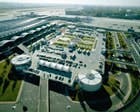For millions of viewers around the world, China’s 80,000-sq-ft Water Cube and the National Stadium “Bird’s Nest” have become synonymous with the Beijing Olympic Games. But for the 17 million Beijing residents, the Olympic Games may well be remembered for something much more basic: a greater abundance of water in China’s capital city.
The city of Beijing has undertaken massive projects to provide an adequate and safe water supply for the Olympic Games, including diverting water from reservoirs and the Yellow River. In addition, conservation and water reuse are becoming increasingly essential to serve the industrial and domestic needs of the country’s growing urban population.
In keeping with its commitment to a “green” Olympics, the city has built 14 wastewater treatment plants since 2001, with a total capacity of 2.68 million cu meters, according to the Beijing Organizing Committee for the Games of the XXIX Olympiad.
In addition, three water reuse projects are underway, employing more than 5,000 FILMTEC 8-in.-diameter reverse osmosis (RO) membrane elements from Dow Water Solutions, a business unit of the Dow Chemical Co. The membranes will help treat 45,000 m3/day of water in the three sites—BeiXiaoHe Wastewater Treatment Plant, Beijing International Airport and the Beijing Economic-Technological Development Area—and will help the city realize its goal to reuse 50% of its water, which will in turn reduce the overall consumption of natural water resources.
“The Olympics have been a good opportunity for Beijing to state the importance of environmental protection and conservation,” said Niann-Tsyr Yuen, Asia-Pacific FILMTEC membranes marketing manager. “Dow Water Solutions is helping China address water shortages and increase the reuse ratio of industrial water so that the municipal water supply can be used for the general population.”
The BeiXiaoHe Wastewater Treatment Plant, built in 1990 to service the surrounding community, began an expansion program in 2006 to increase its capacity to 60,000 m3/day in order to meet the increased water demand for elaborate landscaping designs for the Olympic Games. Dow RO membranes were selected to treat 10,000 m3/day of high-quality water for special use in the Olympic Park’s central lake and fountain, as well as the famous dragon-shape landscape.
The dragon symbol, which influenced the landscaping designs, also inspired the design for Beijing International Airport’s new Terminal 3, the largest airport building in the world. RO membranes will enable 10,000 m3/day of reclaimed wastewater to accommodate the needs of the facility and its 20,000 daily visitors. Yuen says the infrastructure at the Beijing airport will remain after the Olympics to encourage other commercial buildings and area hotels to adopt the reclaimed water for landscaping and other uses.
At the Beijing Economic-Technological Development Area, FILMTEC membranes currently treat 20,000 m3/day for industrial use in electronic, equipment and automobile manufacturing.
Dow’s commitment to apply science and technology to help solve the world’s water crisis and provide pure water for both industrial applications and human use is part of its 2015 Sustainability Goals. Earlier this year, Dow Water Solutions was recognized by ChinaWater magazine as the “Best Water Engineering Company” and “Best Component Supplier.”
“Dow has established excellent relationships with environmental agencies in China and will continue to work with our Beijing partners to use innovative technology to address water shortages in the country,” Yuen said.
Source: Dow Chemical Company


